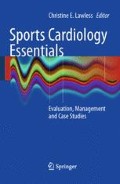Abstract
Exercise is rarely limited by pulmonary causes in healthy individuals. During exercise, large, steep rises in ventilatory demands are met efficiently by the respiratory system while maintaining a substantial breathing reserve. The respiratory system including the lungs and chest wall are often considered “overbuilt” in meeting the demands of exercise.
Access this chapter
Tax calculation will be finalised at checkout
Purchases are for personal use only
References
Rundell KW, Jenkinson DM. Exercise-induced bronchospasm in the elite athlete. Sports Med 2002; 32:583–600
Gotshall RW. Exercise-induced bronchoconstriction. Drugs 2002; 62:1725–1739
Parsons JP, Kaeding C, Phillips G, et al. Prevalence of exercise-induced bronchospasm in a cohort of varsity college athletes. Med Sci Sports Exerc 2007; 39:1487–1492
Parsons JP, Mastronarde JG. Exercise-induced bronchoconstriction in athletes. Chest 2005; 128:3966–3974
McFadden ER, Jr., Lenner KA, Strohl KP. Postexertional airway rewarming and thermally induced asthma. New insights into pathophysiology and possible pathogenesis. J Clin Invest 1986; 78:18–25
Anderson SD, Daviskas E. The mechanism of exercise-induced asthma is. J Allergy Clin Immunol 2000; 106:453–459
Finnerty JP, Holgate ST. Evidence for the roles of histamine and prostaglandins as mediators in exercise-induced asthma: the inhibitory effect of terfenadine and flurbiprofen alone and in combination. Eur Respir J 1990; 3:540–547
Hallstrand TS, Moody MW, Wurfel MM, et al. Inflammatory basis of exercise-induced bronchoconstriction. Am J Respir Crit Care Med 2005; 172:679–686
Helenius I, Haahtela T. Allergy and asthma in elite summer sport athletes. J Allergy Clin Immunol 2000; 106:444–452
Brauer M, Spengler JD. Nitrogen dioxide exposures inside ice skating rinks. Am J Public Health 1994; 84:429–433
Peden DB. Air pollutants, exercise, and risk of developing asthma in children. Clin J Sport Med 2003; 13:62–63
Brudno DS, Wagner JM, Rupp NT. Length of postexercise assessment in the determination of exercise-induced bronchospasm. Ann Allergy 1994; 73:227–231
Godfrey S. Clinical variables of exercise-induced bronchospasm. In: Dempsey J, ed. Muscular exercise and the lung. Madison: The University of Wisconsin Press, 1977; 247–288
Holzer K, Brukner P. Screening of athletes for exercise-induced bronchoconstriction. Clin J Sport Med 2004; 14:134–138
Wilber RL, Rundell KW, Szmedra L, et al. Incidence of exercise-induced bronchospasm in Olympic winter sport athletes. Med Sci Sports Exerc 2000; 32:732–737
Hallstrand TS, Curtis JR, Koepsell TD, et al. Effectiveness of screening examinations to detect unrecognized exercise-induced bronchoconstriction. J Pediatr 2002; 141:343–348
Parsons JP, O’Brien JM, Lucarelli MR, et al. Differences in the evaluation and management of exercise-induced bronchospasm between family physicians and pulmonologists. J Asthma 2006; 43:379–384
Rundell KW, Wilber RL, Szmedra L, et al. Exercise-induced asthma screening of elite athletes: field versus laboratory exercise challenge. Med Sci Sports Exerc 2000; 32:309–316
Anderson SD, Fitch K, Perry CP, et al. Responses to bronchial challenge submitted for approval to use inhaled beta2-agonists before an event at the 2002 Winter Olympics. J Allergy Clin Immunol 2003; 111:45–50
Eliasson AH, Phillips YY, Rajagopal KR, et al. Sensitivity and specificity of bronchial provocation testing. An evaluation of four techniques in exercise-induced bronchospasm. Chest 1992; 102:347–355
Holzer K, Anderson SD, Douglass J. Exercise in elite summer athletes: Challenges for diagnosis. J Allergy Clin Immunol 2002; 110:374–380
Rundell KW, Anderson SD, Spiering BA, et al. Field exercise vs laboratory eucapnic voluntary hyperventilation to identify airway hyperresponsiveness in elite cold weather athletes. Chest 2004; 125:909–915
Holzer K, Anderson SD, Chan HK, et al. Mannitol as a challenge test to identify exercise-induced bronchoconstriction in elite athletes. Am J Respir Crit Care Med 2003; 167:534–537
Anderson SD, Argyros GJ, Magnussen H, et al. Provocation by eucapnic voluntary hyperpnoea to identify exercise induced bronchoconstriction. Br J Sports Med 2001; 35:344–347
National Heart Lung and Blood Institute Expert Panel Report 3. Guidelines for the diagnosis and management of asthma. Bethesda, 2007
McKenzie DC, McLuckie SL, Stirling DR. The protective effects of continuous and interval exercise in athletes with exercise-induced asthma. Med Sci Sports Exerc 1994; 26:951–956
Shturman-Ellstein RZR, Buckley JM, Souhrada JF. The beneficial effect of nasal breathing on exercise-induced bronchoconstriction. Am Rev Respir Dis 1978; 118:65–73
Schacter E. The protective effects of a cold weather mask on EIA. Ann Allergy 1982:12–16
Miller MG, Weiler JM, Baker R, et al. National athletic trainers’ association position statement: management of asthma in athletes. J Athl Train 2005; 40:224–245
Rundell KW, Spiering BA. Inspiratory stridor in elite athletes. Chest 2003; 123:468–474
Hicks M, Brugman SM, Katial R. Vocal cord dysfunction/paradoxical vocal fold motion. Prim Care 2008; 35:81–103, vii
McFadden ER, Jr., Zawadski DK. Vocal cord dysfunction masquerading as exercise-induced asthma. a physiologic cause for “choking” during athletic activities. Am J Respir Crit Care Med 1996; 153:942–947
Torrego Fernandez A, Santos Perez S, Brea Folco J, et al. Dysfunction of the vocal cords simulating exercise-induced asthma. Arch Bronconeumol 2000; 36:533–535
Eisen GM, Sandler RS, Murray S, et al. The relationship between gastroesophageal reflux disease and its complications with Barrett’s esophagus. Am J Gastroenterol 1997; 92:27–31
Pandolfino JE, Bianchi LK, Lee TJ, et al. Esophagogastric junction morphology predicts susceptibility to exercise-induced reflux. Am J Gastroenterol 2004; 99:1430–1436
Jozkow P, Wasko-Czopnik D, Medras M, et al. Gastroesophageal reflux disease and physical activity. Sports Med 2006; 36:385–391
Powell DM, Karanfilov BI, Beechler KB, et al. Paradoxical vocal cord dysfunction in juveniles. Arch Otolaryngol Head Neck Surg 2000; 126:29–34
Truwit J. Pulmonary disorders and exercise. Clin Sports Med 2003; 22:161–180
Author information
Authors and Affiliations
Corresponding author
Editor information
Editors and Affiliations
Rights and permissions
Copyright information
© 2011 Springer Science+Business Media, LLC
About this chapter
Cite this chapter
Parsons, J.P. (2011). Shortness of Breath. In: Lawless, C. (eds) Sports Cardiology Essentials. Springer, New York, NY. https://doi.org/10.1007/978-0-387-92775-6_6
Download citation
DOI: https://doi.org/10.1007/978-0-387-92775-6_6
Published:
Publisher Name: Springer, New York, NY
Print ISBN: 978-0-387-92774-9
Online ISBN: 978-0-387-92775-6
eBook Packages: MedicineMedicine (R0)

